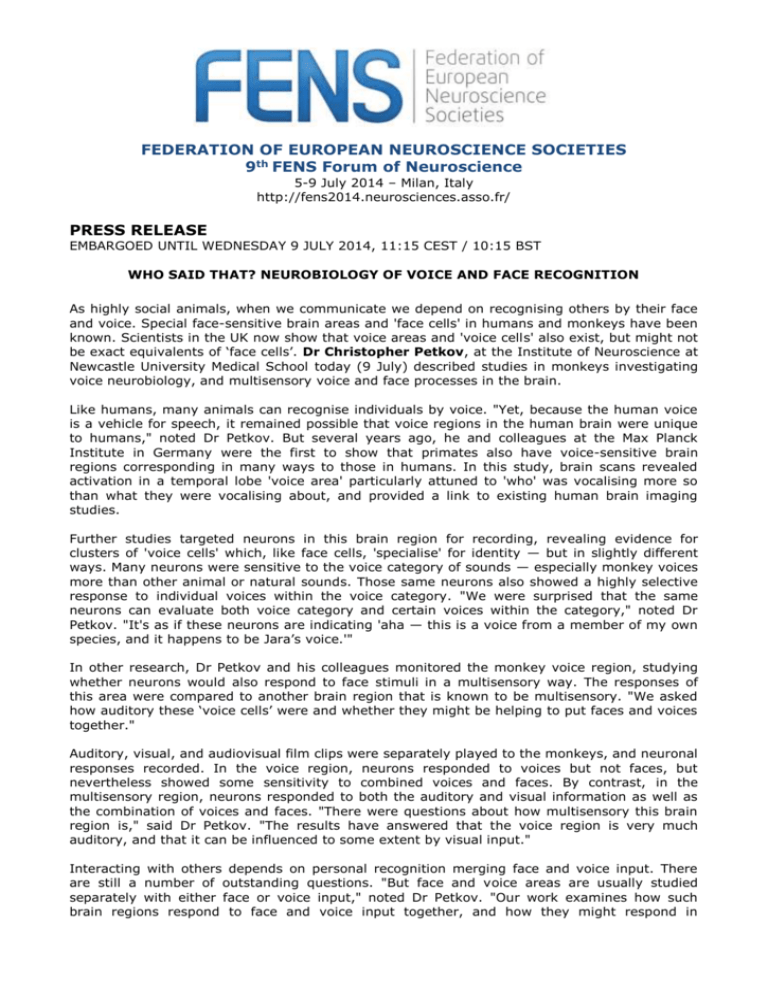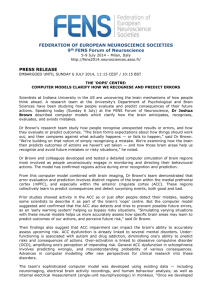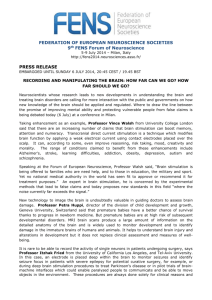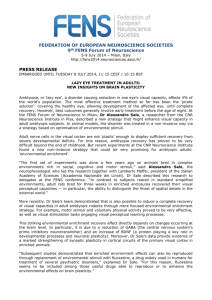who said that? neurobiology of voice and face recognition
advertisement

FEDERATION OF EUROPEAN NEUROSCIENCE SOCIETIES 9th FENS Forum of Neuroscience 5-9 July 2014 – Milan, Italy http://fens2014.neurosciences.asso.fr/ PRESS RELEASE EMBARGOED UNTIL WEDNESDAY 9 JULY 2014, 11:15 CEST / 10:15 BST WHO SAID THAT? NEUROBIOLOGY OF VOICE AND FACE RECOGNITION As highly social animals, when we communicate we depend on recognising others by their face and voice. Special face-sensitive brain areas and 'face cells' in humans and monkeys have been known. Scientists in the UK now show that voice areas and 'voice cells' also exist, but might not be exact equivalents of ‘face cells’. Dr Christopher Petkov, at the Institute of Neuroscience at Newcastle University Medical School today (9 July) described studies in monkeys investigating voice neurobiology, and multisensory voice and face processes in the brain. Like humans, many animals can recognise individuals by voice. "Yet, because the human voice is a vehicle for speech, it remained possible that voice regions in the human brain were unique to humans," noted Dr Petkov. But several years ago, he and colleagues at the Max Planck Institute in Germany were the first to show that primates also have voice-sensitive brain regions corresponding in many ways to those in humans. In this study, brain scans revealed activation in a temporal lobe 'voice area' particularly attuned to 'who' was vocalising more so than what they were vocalising about, and provided a link to existing human brain imaging studies. Further studies targeted neurons in this brain region for recording, revealing evidence for clusters of 'voice cells' which, like face cells, 'specialise' for identity — but in slightly different ways. Many neurons were sensitive to the voice category of sounds — especially monkey voices more than other animal or natural sounds. Those same neurons also showed a highly selective response to individual voices within the voice category. "We were surprised that the same neurons can evaluate both voice category and certain voices within the category," noted Dr Petkov. "It's as if these neurons are indicating 'aha — this is a voice from a member of my own species, and it happens to be Jara’s voice.'" In other research, Dr Petkov and his colleagues monitored the monkey voice region, studying whether neurons would also respond to face stimuli in a multisensory way. The responses of this area were compared to another brain region that is known to be multisensory. "We asked how auditory these ‘voice cells’ were and whether they might be helping to put faces and voices together." Auditory, visual, and audiovisual film clips were separately played to the monkeys, and neuronal responses recorded. In the voice region, neurons responded to voices but not faces, but nevertheless showed some sensitivity to combined voices and faces. By contrast, in the multisensory region, neurons responded to both the auditory and visual information as well as the combination of voices and faces. "There were questions about how multisensory this brain region is," said Dr Petkov. "The results have answered that the voice region is very much auditory, and that it can be influenced to some extent by visual input." Interacting with others depends on personal recognition merging face and voice input. There are still a number of outstanding questions. "But face and voice areas are usually studied separately with either face or voice input," noted Dr Petkov. "Our work examines how such brain regions respond to face and voice input together, and how they might respond in multisensory ways." Their findings suggest that voices and faces might be combined via the voice region interacting with multisensory and other brain areas. "Voice is like an auditory face. Thus studying voice processes provides tangible links to the visual system too." These insights on voice recognition might inform research on human cognitive and communication disorders, such as stroke, which often affects language areas; or voice blindness. Dr Petkov also believes that this research may shed some light on the origins of human communication, via these more ancient brain structures. "Speech is a uniquely human ability. So voice research highlights brain processes that we share with our primate relatives: identifying who is speaking." He hopes ongoing research will demystify and better specify the unique elements of human neurobiology for communication, and in so doing provide insights on brain mechanisms that require animal models. END Abstract Reference R10167: Voice cells in the primate brain: Are they an auditory equivalent to face cells? Symposia S53: Auditory cortical tuning to natural sounds Contact FENS Press Office and all media enquiries: Elaine Snell, Snell Communications Ltd, London UK (English language) tel: +44 (0)20 7738 0424 or mobile +44 (0)7973 953 794 email: Elaine@snell-communications.net Mauro Scanu (Italian language) tel: +39 333 161 5477 email: press.office@fens.org Dr Christopher Petkov chris.petkov@newcastle.ac.uk NOTES TO EDITORS The 9th FENS Forum of Neuroscience, the largest basic neuroscience meeting in Europe, organised by FENS and hosted by the The Società Italiana di Neuroscienze (SINS) (Italian Society for Neuroscience) will attract an estimated 5,500 international delegates. The Federation of European Neuroscience Societies (FENS), founded in 1998, aims to advance research and education in neuroscience, representing neuroscience research in the European Commission and other granting bodies. FENS represents 42 national and mono-disciplinary neuroscience societies with close to 23,000 member scientists from 32 European countries. http://fens2014.neurosciences.asso.fr/ Further Reading (Petkov) Auditory and Visual Modulation of Temporal Lobe Neurons in Voice-Sensitive and Association Cortices. C Perrodin, C Kayser, NK Logothetis, CI Petkov. Journal of Neuroscience, February 2014; 34(7): 2524-2537. DOI: 10.1523/JNEUROSCI.2805-13.2014 Voice Cells in the Primate Temporal Lobe. C Perrodin, C Kayser C, NK Logothetis, CI Petkov. Current Biology. August 2011; 21 (16): 1408-1415. DOI: 10.1016/j.cub.2011.07.028 A Voice Region in the Monkey Brain. CI Petkov, C Kayser, T Steudel, K Whittingstall, M Augath, NK Logothetis. Nature Neuroscience. 2008; Vol. 11, No. 3: 367-374. DOI: 10.1038/nn2043







